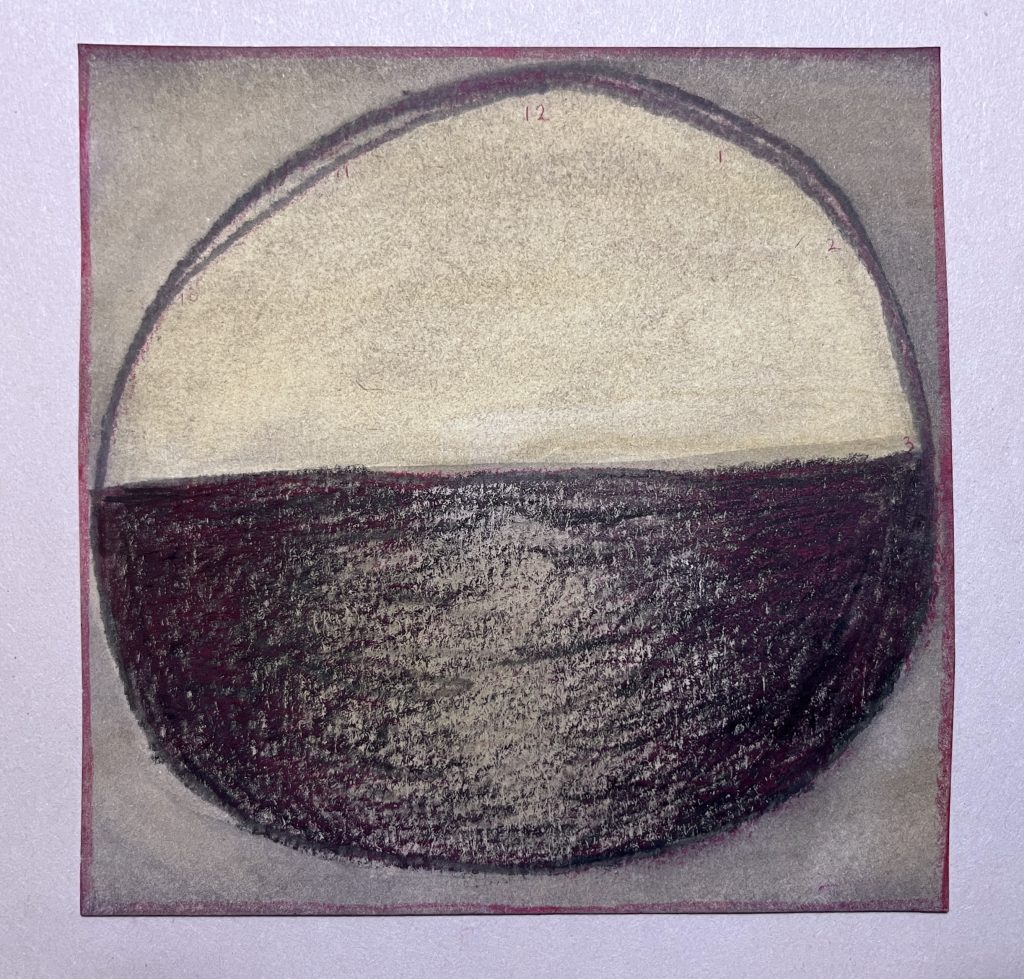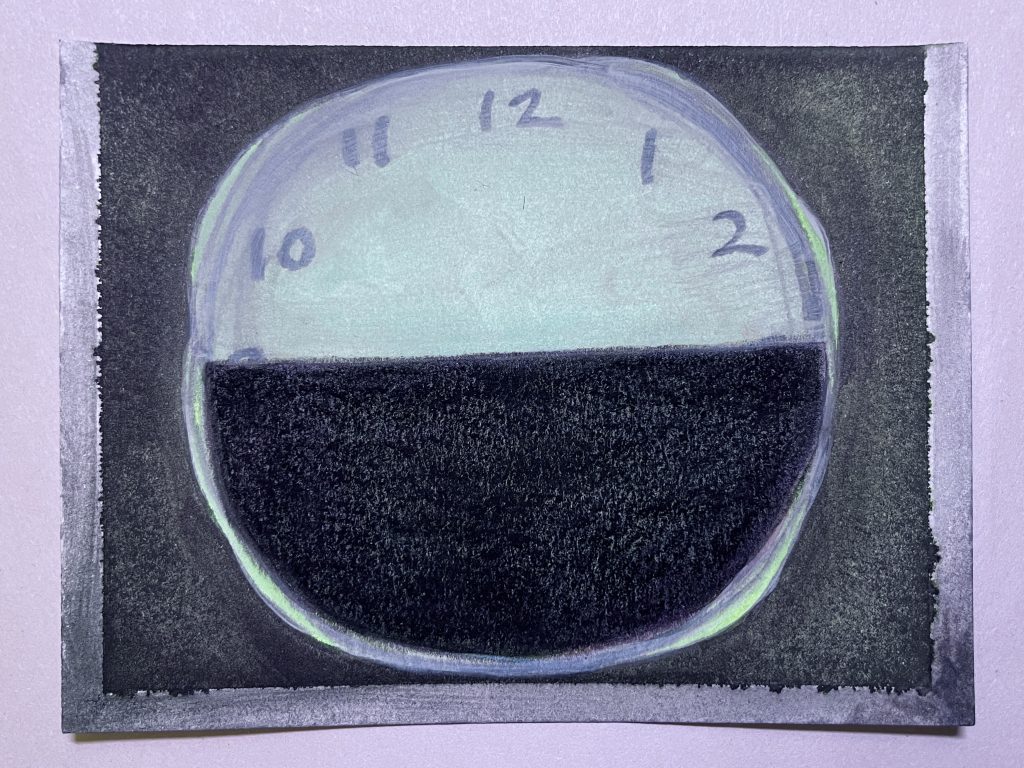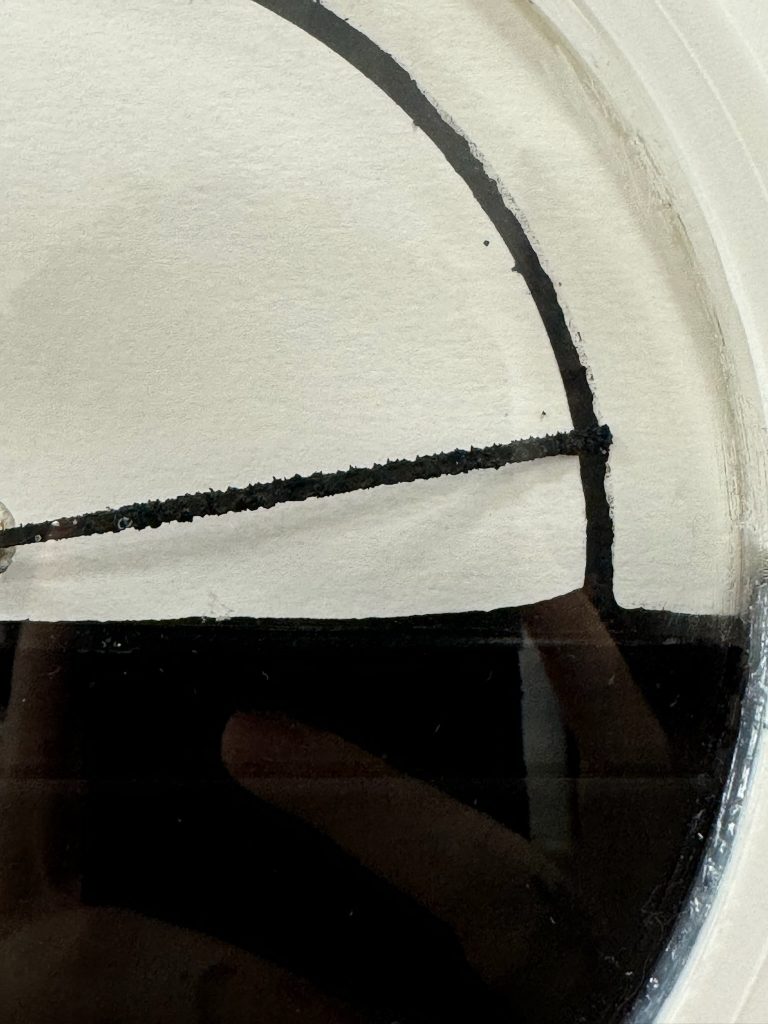By Carmel Dor
The project I developed while in the Makerspace residency came from a body of work that explores the emotional qualities of moving through time during transformative moments of change. My kinetic clock sculptures generally develop out of my drawing and painting practice where I utilize symbols like clock motifs and work in a vein of biomorphic abstraction. The piece I worked on in this residency, now titled “Drowning Clock”, was one that I drew many iterations of before finally realizing it wanted to be a kinetic sculptural object. The drawings were working with the idea of a bottom-heavy form that was pregnant with potential but also holding its breath and waiting.




As I continued to work with this form, it grew to encompass feelings of yearning, of reaching, and trying to accomplish something through the fog of difficulty and uncertainty. I wanted to make a clock that was filled with ink so when the second-hand completed a rotation it would dip into the reservoir and attempt to draw a line arching across the top half of the clock. In each rotation the clock hand would be unable to complete the line as it ran out of ink and would retry the attempt over and over again as a kind of meditative and dedicated act of reaching. The black ink would be opaque so when the second hand is under water the piece falls quiet. The black half circle would also serve as a reflective surface for the viewer to see themselves mirrored in as they wait, returning their gaze. The piece had a few specific elements that needed to function to get this feeling across and so I feel very lucky that I was able to get the support I needed at the Makerspace residency to incorporate new technologies that helped me complete this sculpture.


My residency came at a crucial time when I was stuck between malfunctioning prototype and an exhibition opportunity to show this work. Before the residency started, I had been working on prototypes of this piece for a year. In my first attempts at making this piece I ran into many issues including the ink evaporating in the enclosed clock and fogging up the glass, large crystals forming on the clock hand and obstructing the motion, and the clock leaking from various manufacturing holes on the rear of the prefabricated material. I tried caulking the piece to stop the leaks but then there was no easy way to get the ink in and out of the piece without making a mess. I also couldn’t replace the paper between test-runs without removing the caulk and taking the whole piece apart. Overall, I was feeling like I hit a wall until I started looking at the options available through the Makerspace.



My first instinct was to upgrade my quartz clock mechanism to an Arduino motor so it could overcome the physical tension of drawing on the paper and the crystals that eventually grew on it from prolonged operation. I learned to program the motor and how they internally work to better understand how I could integrate them into my piece. I noticed that the motor would quiver when reduced to the slow speed I chose for this piece, and it wouldn’t be able to draw a smooth line I was after. The motor is magnetic, and the quiver came from the magnet being turned on and off to create the rotation. I tried different clock hands from prefabricated ones to laser cut arms at different lengths and even 3D printed ones in both PLA and resin, but overall, the magnetic nature of the motor meant the motion wouldn’t be quite as smooth. So, I went back to the quartz mechanism and turned to other ways to make the body of the clock to address the other issues that came up in prototyping.
Early in the residency I knew I wanted to create my own body for the clock that had a larger opening at the top so the ink could evaporate without fogging up the piece. I asked a local fabricator to create a clock body to the specifications I needed, and at the same time I worked with the wonderful technicians at the Makerspace to design and print a 3D model of what I thought would be another more tailored version of the clock body. They showed me how to work in Rhino and supported me in the process of tweaking the model as we got closer to the final piece. I also learned how to laser cut plexiglass and was able to cut a face for the clock this way. The laser cut and 3D print we made onsite turned out to be the perfect solution to many of the prototype problems! We designed an open top that allowed for evaporation and was also wide enough so I could easily get the ink in and out as well as replace the paper between installations and adjust the mechanism with ease. While crystals still formed on the clock hand from the Sumi ink I used, they were now smaller and didn’t impede on the clock movement.




The laser cutting process also lent itself well to another experiment I was mulling over in my studio relating to displaying my works on paper. When displaying my finished drawings and watercolors, I prefer not to place them behind glass as it feels like it creates an inert layer of distance. At the Makerspace I experimented with laser cutting a motif I work with often, of an abstracted vaginal opening, onto glass and different colors of plexiglass. Adding this drawn element as the top layer of my works on paper feels like an interesting gesture to experiment with while also allowing the paper below to be more protected. And while the Arduino motors didn’t work out for “Drowning Clock”, now that I know how to work with them, I will be able to move beyond traditional clock mechanisms motions to create more dynamic movements, allowing my kinetic sculptures to embody a wider vernacular body language.



The culmination of my residency is the exhibition of “Drowning Clock” in a two-person show at Partners and Son in Philadelphia with Suji Kanneganti curated by Samantha M Connors (the show runs August 21 – September 22, 2024). In addition to the clock, we are showing a mixture of paintings, drawings, artist books, and a collaborative print all working on or around our experience of the passage of time. Leading up to this exhibition I practiced installing the work and in each installation the clock had a mind of its own and performs in new ways. Sometimes the hand got caught in the surface tension of the ink and twitched as it tried to escape. One time, out of nowhere, it started forming bubbles of ink each time it emerged from the ink pool to start its arc. Occasionally it would build up material very thickly and would get stuck in its arc, needing to be encouraged (released) to complete its journey. In early versions of this piece, the hand was unable to complete drawing the line in one full rotation, but in the latest iteration it defiantly completes each circle – the hand encrusted in dry inky spikes and crystals as it rotates without end. I am constantly surprised and in awe of the ways this piece reinvents itself!
My time at the Makerspace was transformative, not just for this sculpture I created but for my approach to artmaking and broadening the tools I bring into my practice. I’m excited to see what these new methods of working bring to my future works.
For more documentation on Carmel’s work, please visit their artist website.
